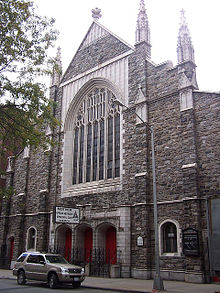- Mother African Methodist Episcopal Zion Church
-
The Mother African Methodist Episcopal Zion Church (also known as "Mother Zion") is the oldest African-American church in New York City, as well as New York State. It is a New York City Designated Historic Site as of 1993. "Mother Zion" is located in the historic Harlem neighbourhood in the borough of Manhattan, at 140-148 West 137th Street.
Contents
Building
The Mother African Methodist Episcopal Zion Church building was constructed between 1923-25. The "Mother Zion" church building was designed by architect George W. Foster, Jr., who was one of the first registered African-American architects in the United States. The building is the sixth church building to house New York City's first black congregation. It is also the founding congregation of the African Methodist Episcopal Zion Church, or A.M.E. Zion conference.[1]
The building is neo-Gothic in style, similar to several other Protestant churches raised in Manhattan during the late 19th century and early 20th century. Mother Zion has an "auditorium" layout, of a type that was becoming popular with Protestant congregations at the time (rather than a "cross" form of layout, which has a deep chancel for the altar, and a long nave intersected by two transcepts). The seating is arranged in a wide arc around the altar and pulpit, and features a wide balcony on the second level, also in an arc layout. Seating capacity inside the church is about 1000.[2]
History
The Mother A.M.E. Zion congregation was first formed in 1796 by African-American members of the predominantly white John Street Methodist Church. Although the John Street Methodist Church was Abolitionist in its orientation, racial segregation was still enforced in other ways. As one A.M.E. Zion historian described it:
The colored members were not permitted to come to the sacrament (Holy Communion) until all the white members, even children, had communed.[3]The founding bishop who led the congregation was James Varick, whose tomb is located underneath the current building's sanctuary. The original congregation numbered about 100 members, who met in a rented hall.[4] The congregation met at several other locations in Manhattan before settling at the present location of the Mother Zion church building.
The A.M.E. Zion conference was referred to nationally as the "Freedom Church" for its vital role in the United States Abolitionist movement. The "Mother Zion" church was not only New York City's first African-American congregation, it was an "Underground Railway" refuge.[5] Sojourner Truth was a member of the congregation, and spoke out from the pulpit against slavery. Harriet Tubman and Frederick Douglass were members of the A.M.E. Zion conference at other congregations. Mother Zion's identification with the abolitionist movement led to it being attacked by an anti-black mob during a three-day riot in 1834. Windows were smashed at Mother Zion, and several black and white churches were set ablaze. The July 12, 1834 New York Evening Post newspaper denounced the attacks as a "disgrace".[6]
Mother Zion also became an important cultural centre for the city's African-American community. Paul Robeson, brother of Pastor Dr. Benjamin C. Robeson, spoke from the pulpit. Dr. Robeson's activism for civil rights led him to work with prominent Harlem Renaissance members such as Langston Hughes and W.E.B. Dubois.[7]
Today, the Mother Zion church continues to sponsor a variety of social programs aimed at assisting members of the congregation and the surrounding community. Several historic artifacts from the church's 200-year history are on display in the vestibule.
The larger congregation of churches belonging to the African Methodist Episcopal Zion Church today has around 1.3 million members in the United States, Canada, Africa and Latin America.
See also
- African Methodist Episcopal Zion Church
- James Varick
- Underground railroad
- African-American church
- Harriet Tubman
- Harlem Renaissance
- List of New York City Designated Landmarks in Manhattan above 110th Street
External links
References
- ^ Landmarks Preservation Commission, New York City. "Mother African Methodist Episcopal Zion Church". Neighbourhood Preservation Center. http://www.neighborhoodpreservationcenter.org/db/bb_files/Mother-African-Methodist-Episcopal-Zion-Church.pdf. Retrieved November 20, 2011.
- ^ Landmarks Preservation Commission, New York City. "Mother African Methodist Episcopal Zion Church". Neighbourhood Preservation Center. http://www.neighborhoodpreservationcenter.org/db/bb_files/Mother-African-Methodist-Episcopal-Zion-Church.pdf. Retrieved November 20, 2011.
- ^ Landmarks Preservation Commission, New York City. "Mother African Methodist Episcopal Zion Church". Neighbourhood Preservation Center. http://www.neighborhoodpreservationcenter.org/db/bb_files/Mother-African-Methodist-Episcopal-Zion-Church.pdf. Retrieved November 20, 2011.
- ^ "Mapping the African American Past: Mother AME Zion Church". Columbia University. http://maap.columbia.edu/place/14.html. Retrieved November 20, 2011.
- ^ Landmarks Preservation Commission, New York City. "Mother African Methodist Episcopal Zion Church". Neighbourhood Preservation Center. http://www.neighborhoodpreservationcenter.org/db/bb_files/Mother-African-Methodist-Episcopal-Zion-Church.pdf. Retrieved November 20, 2011.
- ^ "Riots and Continued Disturbances of the Peace". New York Evening Post: pp. 1. July 12, 1834.
- ^ Landmarks Preservation Commission, New York City. "Mother African Methodist Episcopal Zion Church". Neighbourhood Preservation Center. http://www.neighborhoodpreservationcenter.org/db/bb_files/Mother-African-Methodist-Episcopal-Zion-Church.pdf. Retrieved November 20, 2011.
Categories:- Landmarks in Manhattan
- African American history of New York
- Underground Railroad locations
- Methodist churches in New York
Wikimedia Foundation. 2010.

